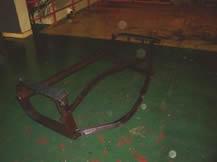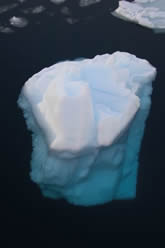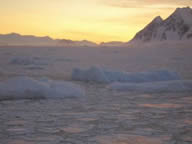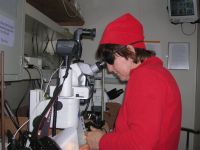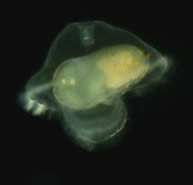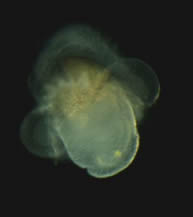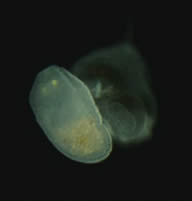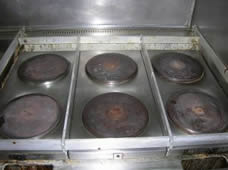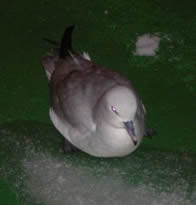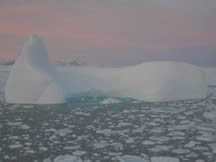
 |
| Academic Departments | Student Services | Alumni | Research | Outreach | Diversity |
| 1 | 2 | 3 | 4 | 5 | 6 | |
| 7 | 8 | 9 | 10 | 11 | 12 | 13 |
| 14 | 15 | 16 | 17 | 18 | 19 | 20 |
| 21 | 22 | 23 | 24 | 25 | 26 | 27 |
| 28 | 29 | 30 | 31 |
| 1 | 2 | 3 | ||||
| 4 | 5 | 6 | 7 | 8 | 9 | 10 |
| 11 | 12 | 13 | 14 | 15 | 16 | 17 |
| 18 | 19 | 20 | 21 | 22 | 23 | 24 |
| 25 | 26 | 27 | 28 | 29 | 30 |
Daily Journals
June 1, 2006
Last night (well, 0100 for me), the view wasn’t quite as spectacular, but it was still an interesting ride from the Bridge. We were in mostly pancake ice which doesn’t make any noise when it rubs along the hull mixed with some pretty good sized ‘growlers’, which do make noise when in contact with the hull. As a matter of fact, growlers can put a dent in our hull. I’ll get to that lesson later, but in the meantime I wanted to give beauty-credit to the artificial effects here. The ship’s lights are always on, so there are no dark decks. During the darkest hours, though, they run big spotlights off the bow and forward quarters to watch for threatening floating ice. The light from that beam that drops down on the snowcovered giant lilypads below, gives the snow a sparkle that reminds me of January in moonlight. It was mesmerizing. There were science operations going on around 10 p.m. last night, including a haul by the Blake dredge that included a 300 pound rock! That rock so wedge itself into the front blades of the dredge (see the Auburn Univ. link on the WHOI web’s Antarctica page to see the shape it should be), that it bent the blades into a larger, not-so-flat-anymore opening. That poor puppy will have to be repaired before it will be of any use for a while. Besides rocks on the bottom, there were hazards at the surface. I’ve mentioned the presence of ‘growler’ icebergs, and how they can be a problem. These large (up to 5 meters or so, then they’re officially “icebergs”) chunks of ice bob slowly at the sea’s surface. The lights pick them up very well, but if you see it when it’s down in the water, it might look fairly small. Look again, and it has risen high in the water showing it’s full girth! The helmsman must be very alert, and let other people on the deck know when there are ‘growlers’ coming into the path of the ship when operations are going on at the rear, and must change course slightly to stay out of their way. Getting to Know …Your Ice Development of Land Ice: Water Vapor - crystallizes and becomes Ice Sheet - A mass of ice and snow of considerable thickness and large area on rock or floating on water. An ice sheet of greater than 50,000 square km is called an ice cap. Glacier - A mass of snow and ice continuously moving from higher to lower ground, or if afloat, constantly spreading.
Ice Berg - A large mass of floating ice, more than 5 meters above sea level that has broken away from a glacier Growler - A piece of floating ice, smaller than a bergy bit, almost awash. Development of Sea Ice: Sea Water - (which on average, freezes at -1.9°C) Shuga -
An accumulation of spongy white lumps, a few centimeters across formed from slush or grease ice. Slush - Snow, saturated with water floating after a heavy snowfall Ice Cake less than 10 meters across Small : 10 to 100 meters across Medium : 100 to 1000 meters across Big : 1 to 10 kilometers across Vast : Over 10 kilometers across Ready for the Quiz??????
Back to the Science I had the pleasure of assisting Susie Balser in the photo lab as she took microscope photos of some interesting plankton specimens. One of these that you've seen before, the pilidium larva that turns into a ribbon worm, was being particularly cooperative. We were able to watch, through the lens of the camera, a pilidium ‘give birth’ to a tiny ribbon worm!! Part of the ‘gut’ in that almost clear helmet-shaped larva, is really a tiny worm forming. Susie caught one whose worm juvenile (the larva is really the “baby”) was ready to crawl out of it’s developmental home. Over the course of about 45 minutes and several gentle phrases of encouragement (things like “come on, we’re friendly” and “if you come out, you'll be famous!”), drops of water to give it more ‘space’ to work in, and extreme patience, that little worm with his tiny yellow eyes (photoreceptors) and big goofy grin wriggled free of it’s shelter and went on its way (to get a job, I presume. This thing developed so quickly, I expect by this morning he was already going to college!). Wait til you see this… you'll just want to name him and take him home!!! The belief is that the larval housing will clone another worm rather than disintegrate. Stay tuned… Don't hesitate to email questions to us at outreach@lmg.usap.gov
|
Longitude/Latitude: S68° 18.208’ W68° 18.439’ Temperature: Wind: ESE 12-15 kn Wind Chill: -13.5°C
Menu: Pork chops, meatloaf, mashed potato, asparagus, mixed vegs, rice, salad; Beef stew, baked cod, Brussels sprouts, rice, salad, banana bread, pineapple upside down cake, pudding and cookies.
Photos:Blake Dredge needs orthodonture. [Photo by Chris Mah]
Nice ‘Bergy Bit’ notice how much is ‘Pancakes’ mixed with ‘growlers’. [Photo by E. Bailey]
Dr. Susie Balser in the photo lab.
top: Stage 1 middle: Stage 2 bottom: Stage 3
Time to corral the pans again… [Photo by E. Bailey]
Stowaway Southern Fulmar on fore deck.
N’ Iceberg in Marguerite Bay. [Photo by E. Bailey] |
- Alabama Agricultural Experiment Station
- Alabama Cooperative Extension System
- Auburn Online Community
- Bookstore
- Center for Diversity
- Crisis/Incident Assistance
- Diversity and Multicultural Affairs
- Financial Aid
- Hotel and Conference Center
- Jule Collins Smith Museum of Fine Art
- Medical Clinic
- Southeastern Raptor Center
- Special Reports
- Students w/ Disabilities
- Theatre
